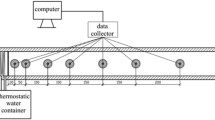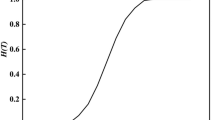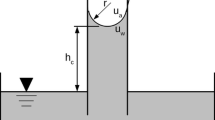Abstract
Shallow horizontal ground loops harness stored subsurface thermal energy and operate in conditions where the moisture and temperature of the surrounding soil vary spatially and temporally. The thermal conductivity of the soil is dependent on soil moisture and temperature and is a design parameter that greatly influences the size and performance of horizontal ground loops. However, soil thermal conductivity is often assumed to be constant and conservative estimates are used in the design of ground loops. Two fundamental constitutive relationships, the thermal conductivity dryout curve (TCDC) and the soil–water characteristic curve (SWCC), can be coupled and used to quantify transient moisture-dependent thermal behavior of soil. In this study, coupled TCDCs and SWCCs were utilized in two-dimensional models based on the finite-element method to predict moisture migration effects on transient hydraulic and thermal behavior of unsaturated soil surrounding geothermal exchange loops. Soil thermal conductivity predicted from using coupled TCDCs and SWCCs are compared to the conventional method of using a conservative value. Results suggest that employing coupled TCDCs and SWCCs can provide realistic and improved values of soil thermal conductivity for the design of horizontal ground loops.









Similar content being viewed by others
References
Abu-Hamdeh NH, Reeder RC (2000) Soil thermal conductivity effects of density, moisture, salt concentration, and organic matter. Soil Sci Soc Am J 64(4):1285–1290
Agus SS, Schanz T (2005) Comparison of four methods for measuring total suction. Vadose Zone J 4(4):1087–1095
ASHRAE (2007) Geothermal energy. ASHRAE handbook: HVAC applications, American society of heating, refrigerating and air conditioning engineers
Benazza A, Blanco E, Aichouba M, Rio JL, Laouedj S (2011) Numerical investigation of horizontal ground coupled heat exchanger. Energy Procedia 6:29–35
Campbell GS, Jungbauer JD Jr, Bidlake WR, Hungerford RD (1994) Predicting the effect of temperature on soil thermal conductivity. Soil Sci 158(5):307–313
Chiasson AD (2010) Modeling horizontal ground heat exchangers in geothermal heat pump systems. In: Proceedings of COMSOL conference
Chong CSA, Gan G, Verhoef A, Garcia RG, Vidale PL (2012) Simulation of thermal performance of horizontal slinky-loop heat exchangers for ground source heat pumps. Appl Energy 104:603–610
Congedo PM, Colangelo G, Starace G (2012) CFD simulations of horizontal ground heat exchangers: a comparison among different configurations. Appl Therm Eng 33:24–32
Côté J, Konrad JM (2005) A generalized thermal conductivity model for soils and construction materials. Can Geotech J 42(2):443–458
Demir H, Koyun A, Temir G (2009) Heat transfer of horizontal parallel pipe ground heat exchanger and experimental verification. Appl Therm Eng 29(2):224–233
Farouki OT (1981) Thermal properties of soils. United States Army Corps of Engineers CRREL, Hanover
Florides G, Kalogirou S (2007) Ground heat exchangers—a review of systems, models and applications. Renew Energy 32(15):2461–2478
Fredlund DG, Xing A (1994) Equations for the soil–water characteristic curve. Can Geotech J 31(4):521–532
Hillel D (1982) Introduction to soil physics. Academic Press, New York
İnallı M, Esen H (2005) Seasonal cooling performance of a ground-coupled heat pump system in a hot and arid climate. Renew Energy 30(9):1411–1424
Incropera FP, DeWitt DP, Bergman TL, Lavine AS (2006) Fundamentals of heat and mass transfer, 6th edn. Wiley, Hoboken
Krishnapillai SH, Ravichandran N (2012) New soil–water characteristic curve and its performance in the finite-element simulation of unsaturated soils. Int J Geomech 12(3):209–219
Kusuda T, Achenbach PR (1965) Earth temperature and thermal diffusivity at selected stations in the United States. National Bureau of Standards
Leij FJ, Alves WJ, van Genuchten MT, Williams JR (1996) The UNSODA unsaturated hydraulic database. U.S. Environmental Protection Agency, Cincinnati, Ohio
Likos WJ, Olson HS, Jaafar R (2012) Comparison of laboratory methods for measuring thermal conductivity of unsaturated soils. GeoCongress 2012 state of the art and practice in geotechnical engineering, ASCE: 4366–4375
Neher JH, McGrath MH (1957) The calculation of the temperature rise and load capability of cable systems. AIEE Trans 76(3):752–772
Remund C, Carda R (2009) Ground source heat pump residential and light commercial design and installation guide. Oklahoma State University and International Ground Source Heat Pump Association
Salomone LA, Kovacs WD (1984) Thermal resistivity of soils. J Geotech Eng 110(3):375–389
Smits KM, Sakaki T, Limsuwat A, Illangasekare TH (2010) Thermal conductivity of sands under varying moisture and porosity in drainage–wetting cycles. Vadose Zone J 9(1):172–180
Smits KM, Sakaki T, Howington SE, Peters JF, Illangasekare TH (2012) Temperature dependence of thermal properties of sands across a wide range of temperatures (30–70 °C). Vadose Zone J 12(1):1–8
Tarnawski VR, Leong WH, Momose T, Hamada Y (2009) Analysis of ground source heat pumps with horizontal ground heat exchangers for northern Japan. Renew Energy 34(1):127–134
Thode R, Zhang J (2009) SVHeat 1D/2D/3D geothermal modeling software theory manual. SoilVision® Systems Ltd
van Genuchten MT (1980) A closed-form equation for predicting the hydraulic conductivity of unsaturated soils. Soil Sci Soc Am J 44(5):892–898
Williams GP, Gold LW (1976) Ground temperatures. Can Build Dig. National Research Council of Canada, Institute for Research in Construction
Woodward NR, Tinjum JM, Wu R (2013) Water migration impacts on thermal resistivity testing procedures. Geotech Test J 36(6):948–955
Wu Y, Gan G, Verhoef A, Vidale PL, Gonzalez RG (2010) Experimental measurement and numerical simulation of horizontal-coupled slinky ground source heat exchangers. Appl Therm Eng 30(16):2574–2583
Acknowledgments
Mr. Jim Zhang and Mr. Rob Thode of SoilVision® Systems are gratefully acknowledged for their assistance in the numerical simulations. Special thanks are also offered to Mr. Jun Yao and Mr. Hyunjun Oh of the University of Wisconsin-Madison for their efforts in conducting laboratory experiments.
Author information
Authors and Affiliations
Corresponding author
Rights and permissions
About this article
Cite this article
Wu, R., Tinjum, J.M. & Likos, W.J. Coupled Thermal Conductivity Dryout Curve and Soil–Water Characteristic Curve in Modeling of Shallow Horizontal Geothermal Ground Loops. Geotech Geol Eng 33, 193–205 (2015). https://doi.org/10.1007/s10706-014-9811-2
Received:
Accepted:
Published:
Issue Date:
DOI: https://doi.org/10.1007/s10706-014-9811-2




